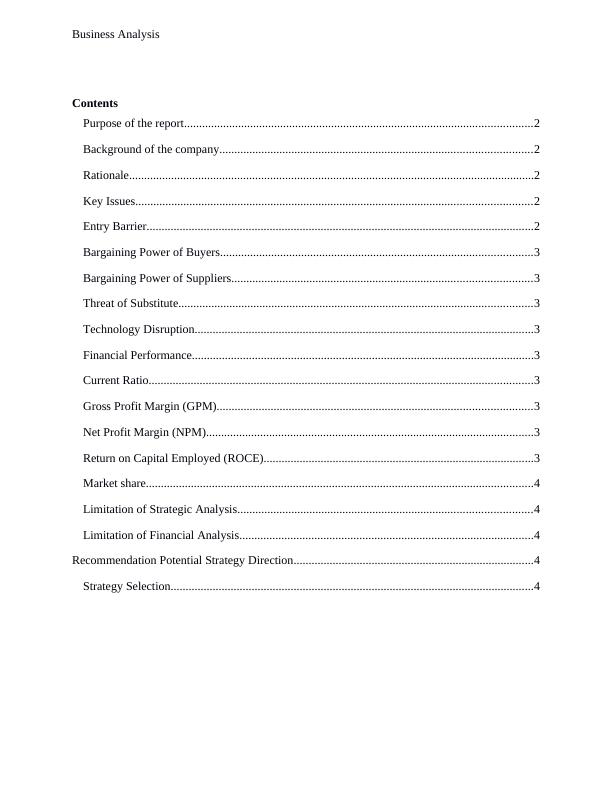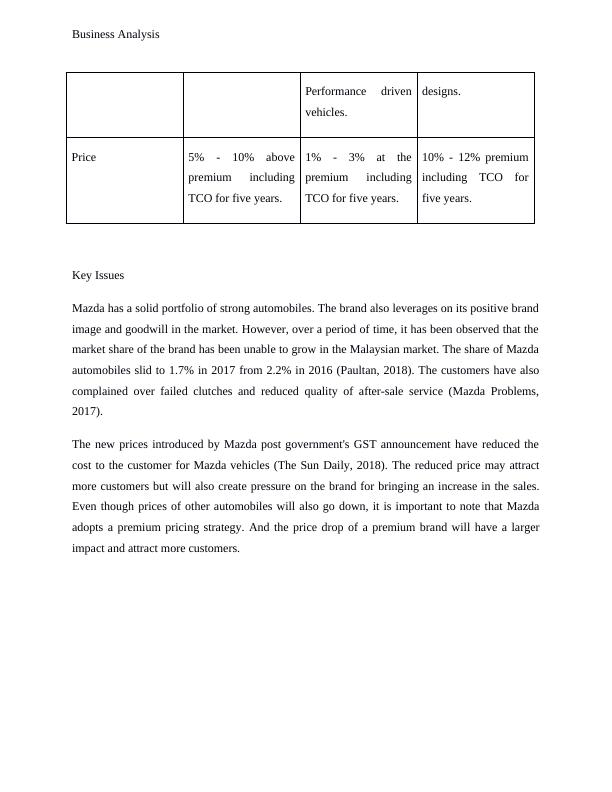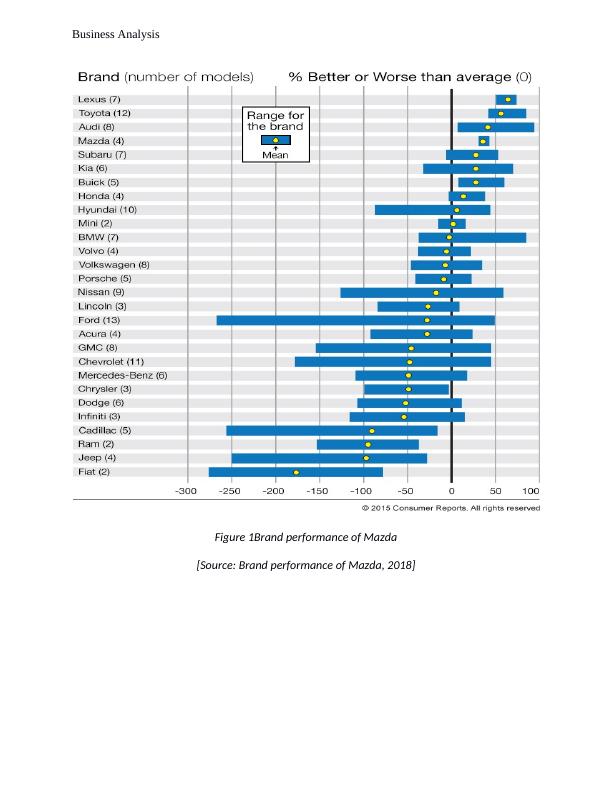Business Analysis of Mazda: Strategy, Financial Performance and Industry Analysis
Added on 2023-06-11
23 Pages4578 Words67 Views
Running Header: Business Analysis

Business Analysis
Contents
Purpose of the report....................................................................................................................2
Background of the company........................................................................................................2
Rationale.......................................................................................................................................2
Key Issues....................................................................................................................................2
Entry Barrier.................................................................................................................................2
Bargaining Power of Buyers........................................................................................................3
Bargaining Power of Suppliers....................................................................................................3
Threat of Substitute......................................................................................................................3
Technology Disruption.................................................................................................................3
Financial Performance..................................................................................................................3
Current Ratio................................................................................................................................3
Gross Profit Margin (GPM).........................................................................................................3
Net Profit Margin (NPM).............................................................................................................3
Return on Capital Employed (ROCE)..........................................................................................3
Market share.................................................................................................................................4
Limitation of Strategic Analysis..................................................................................................4
Limitation of Financial Analysis..................................................................................................4
Recommendation Potential Strategy Direction................................................................................4
Strategy Selection.........................................................................................................................4
Contents
Purpose of the report....................................................................................................................2
Background of the company........................................................................................................2
Rationale.......................................................................................................................................2
Key Issues....................................................................................................................................2
Entry Barrier.................................................................................................................................2
Bargaining Power of Buyers........................................................................................................3
Bargaining Power of Suppliers....................................................................................................3
Threat of Substitute......................................................................................................................3
Technology Disruption.................................................................................................................3
Financial Performance..................................................................................................................3
Current Ratio................................................................................................................................3
Gross Profit Margin (GPM).........................................................................................................3
Net Profit Margin (NPM).............................................................................................................3
Return on Capital Employed (ROCE)..........................................................................................3
Market share.................................................................................................................................4
Limitation of Strategic Analysis..................................................................................................4
Limitation of Financial Analysis..................................................................................................4
Recommendation Potential Strategy Direction................................................................................4
Strategy Selection.........................................................................................................................4

Business Analysis
Introduction
Purpose of the report
This report throws light on the business strategy of the selected company Mazda. This has been
achieved by pitting the performance of the brand against its competitors Honda and Toyota. The
idea behind conducting this analysis is to effectively evaluate the brand’s current position and
benchmarking the same against Toyota and Honda by comparing various attributes of all the
three brands as well as their market shares in the industry. The report highlights various facets of
Mazda as an organization including its structures, policies, and operations. Recommendations for
future growth have been made in order to analyze growth opportunities for Mazda. The report is
also expected to assist stakeholders of the business to achieve proficiency.
Background of the company
Mazda Motor Corporation or better known as Mazda is a leading automobile manufacturer based
out of Japan. Mazda was founded in 1920 and serves customers worldwide (Mazda, 2018).
Mazda has been in partnership with Ford Motor Company from 1974 to 2015 (Auto News 2015).
Mazda has a large customer base across the globe and has adopted innovative marketing and
public relations strategy to sustain its goodwill in the market. The brand is well known for the
quality of automobile it manufactures as well as the efficiency of its after-sale service. In the
year 2015, Mazda manufactured 1.5 million vehicles for global sales. The same year, Mazda was
declared as the fifteenth largest automaker in the world in terms of production (Car Covers,
2016).
Rationale
The rationale behind this report is to benchmark Mazda’s competitive advantage against two of
its leading competitors including Toyota and Honda. In terms of total sales, Honda ranks first
while Toyota ranks third all over the globe (Forbes, 2017). Until 2017, Mazda ranked 10th in the
Malaysian market in terms of Car sales value (Paultan, 2017). Clearly, there is significant room
for improvement for Mazda in terms of increasing the number of manufactured units and hence
total sales.
Introduction
Purpose of the report
This report throws light on the business strategy of the selected company Mazda. This has been
achieved by pitting the performance of the brand against its competitors Honda and Toyota. The
idea behind conducting this analysis is to effectively evaluate the brand’s current position and
benchmarking the same against Toyota and Honda by comparing various attributes of all the
three brands as well as their market shares in the industry. The report highlights various facets of
Mazda as an organization including its structures, policies, and operations. Recommendations for
future growth have been made in order to analyze growth opportunities for Mazda. The report is
also expected to assist stakeholders of the business to achieve proficiency.
Background of the company
Mazda Motor Corporation or better known as Mazda is a leading automobile manufacturer based
out of Japan. Mazda was founded in 1920 and serves customers worldwide (Mazda, 2018).
Mazda has been in partnership with Ford Motor Company from 1974 to 2015 (Auto News 2015).
Mazda has a large customer base across the globe and has adopted innovative marketing and
public relations strategy to sustain its goodwill in the market. The brand is well known for the
quality of automobile it manufactures as well as the efficiency of its after-sale service. In the
year 2015, Mazda manufactured 1.5 million vehicles for global sales. The same year, Mazda was
declared as the fifteenth largest automaker in the world in terms of production (Car Covers,
2016).
Rationale
The rationale behind this report is to benchmark Mazda’s competitive advantage against two of
its leading competitors including Toyota and Honda. In terms of total sales, Honda ranks first
while Toyota ranks third all over the globe (Forbes, 2017). Until 2017, Mazda ranked 10th in the
Malaysian market in terms of Car sales value (Paultan, 2017). Clearly, there is significant room
for improvement for Mazda in terms of increasing the number of manufactured units and hence
total sales.

Business Analysis
Toyota Honda Mazda
Local distributors UMW Toyota motors
is an assembler and
exporter of Toyota
vehicles in Malaysia.
DRB Hicom and Kah
Motors showroom are
leading Honda
distributors.
Bermaz auto Berhad
is the distributor of
all Mazda vehicles
based in Malaysia
(Mazda 2018).
Listing (KLCE) TM HMC MZDAF
Target customers Toyota targets high
and middle-income
groups. For Sedan
sales, families are
targeted. The younger
generation is targeted
through SUVs.
Honda targets all
income groups. The
brand has mid-sized
sedans that help in
target families. Solar
cars have also been
developed to target
environmentally
aware and conscious
people.
Mazda targets
premium customers.
Instead of
demographic, Mazda
targets its customers
by psychographics
and hence appeals to
people who share the
same love for driving
(WARC, 2017).
Benefits offered High-quality cars.
Superior design.
Reliable.
Excellent after sale
service.
Strong and sturdy
exteriors.
Top quality customer
service.
High-speed vehicles.
State of the art
Toyota Honda Mazda
Local distributors UMW Toyota motors
is an assembler and
exporter of Toyota
vehicles in Malaysia.
DRB Hicom and Kah
Motors showroom are
leading Honda
distributors.
Bermaz auto Berhad
is the distributor of
all Mazda vehicles
based in Malaysia
(Mazda 2018).
Listing (KLCE) TM HMC MZDAF
Target customers Toyota targets high
and middle-income
groups. For Sedan
sales, families are
targeted. The younger
generation is targeted
through SUVs.
Honda targets all
income groups. The
brand has mid-sized
sedans that help in
target families. Solar
cars have also been
developed to target
environmentally
aware and conscious
people.
Mazda targets
premium customers.
Instead of
demographic, Mazda
targets its customers
by psychographics
and hence appeals to
people who share the
same love for driving
(WARC, 2017).
Benefits offered High-quality cars.
Superior design.
Reliable.
Excellent after sale
service.
Strong and sturdy
exteriors.
Top quality customer
service.
High-speed vehicles.
State of the art

Business Analysis
Performance driven
vehicles.
designs.
Price 5% - 10% above
premium including
TCO for five years.
1% - 3% at the
premium including
TCO for five years.
10% - 12% premium
including TCO for
five years.
Key Issues
Mazda has a solid portfolio of strong automobiles. The brand also leverages on its positive brand
image and goodwill in the market. However, over a period of time, it has been observed that the
market share of the brand has been unable to grow in the Malaysian market. The share of Mazda
automobiles slid to 1.7% in 2017 from 2.2% in 2016 (Paultan, 2018). The customers have also
complained over failed clutches and reduced quality of after-sale service (Mazda Problems,
2017).
The new prices introduced by Mazda post government's GST announcement have reduced the
cost to the customer for Mazda vehicles (The Sun Daily, 2018). The reduced price may attract
more customers but will also create pressure on the brand for bringing an increase in the sales.
Even though prices of other automobiles will also go down, it is important to note that Mazda
adopts a premium pricing strategy. And the price drop of a premium brand will have a larger
impact and attract more customers.
Performance driven
vehicles.
designs.
Price 5% - 10% above
premium including
TCO for five years.
1% - 3% at the
premium including
TCO for five years.
10% - 12% premium
including TCO for
five years.
Key Issues
Mazda has a solid portfolio of strong automobiles. The brand also leverages on its positive brand
image and goodwill in the market. However, over a period of time, it has been observed that the
market share of the brand has been unable to grow in the Malaysian market. The share of Mazda
automobiles slid to 1.7% in 2017 from 2.2% in 2016 (Paultan, 2018). The customers have also
complained over failed clutches and reduced quality of after-sale service (Mazda Problems,
2017).
The new prices introduced by Mazda post government's GST announcement have reduced the
cost to the customer for Mazda vehicles (The Sun Daily, 2018). The reduced price may attract
more customers but will also create pressure on the brand for bringing an increase in the sales.
Even though prices of other automobiles will also go down, it is important to note that Mazda
adopts a premium pricing strategy. And the price drop of a premium brand will have a larger
impact and attract more customers.

Business Analysis
Figure 1Brand performance of Mazda
[Source: Brand performance of Mazda, 2018]
Figure 1Brand performance of Mazda
[Source: Brand performance of Mazda, 2018]

End of preview
Want to access all the pages? Upload your documents or become a member.
Related Documents
Case Study of Tesla Assignmentlg...
|10
|2718
|66
Marketing Plan Assignment : Toyotalg...
|23
|6298
|269
Global Business in the Asian Centurylg...
|4
|972
|410
Market Analysis of Mazda Motor Corporationlg...
|22
|4901
|193
Corporate Finance Analysislg...
|14
|4046
|265
Situation Analysis of Consumer Behavior Toyotalg...
|22
|5047
|1800